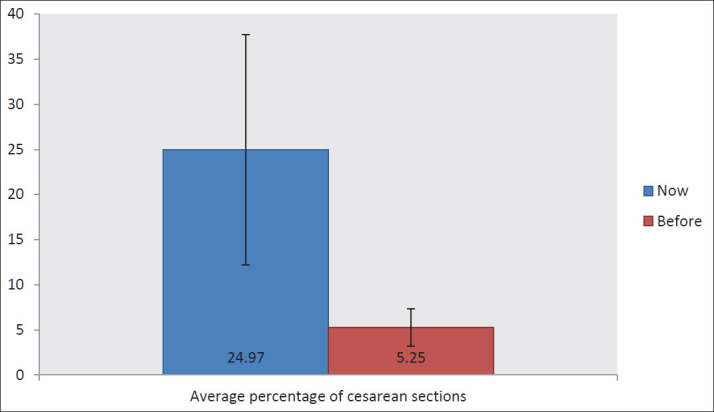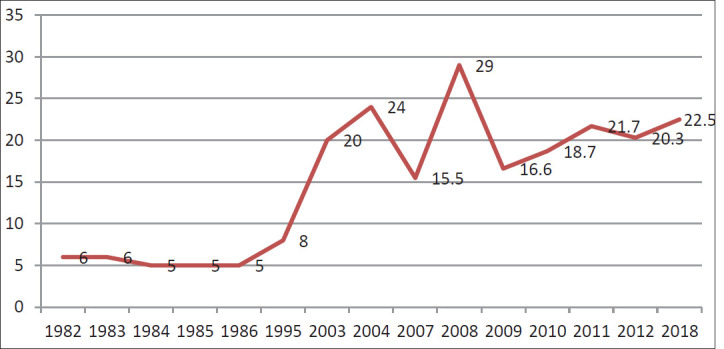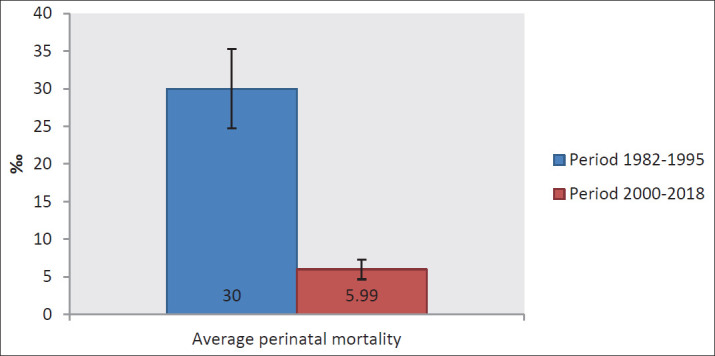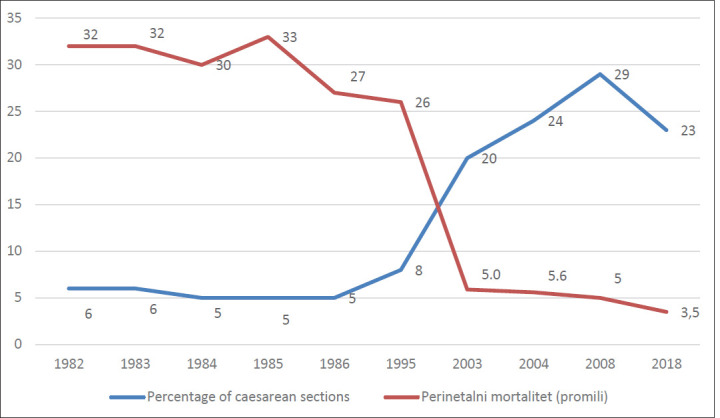Abstract
Introduction:
The health implications of Caesarean section are a significant factor in evaluating the use of Caesarean section as a method of completing childbirth. The increased rate of Cesarean section augmenting in a statistical way the health implications of the use of Cesarean section as a way of operative technique of childbirth finalization.
Aim:
To investigate the incidence of health implications on mother and child after Cesarian section in comparison to vaginal delivery.
Methods:
In our study, which was conducted as a retrospective-prospective and targeted study, the observed research period is from 2007 to 2019. The data sources are: medical histories, birth protocols and neonatal medical histories. Group A: represents the number of surveyed patients with a Cesarean section in a one-year period (2018) in General Hospital „Prim.dr A. Nakaš“. Group B: represents a control group of the same number of patients born by Caesarean section in 2007 in General Hospital „Prim.dr A.Nakaš“ with all parameters and variables detected in the research group. Evaluation of the examinee’s findings includes: anamnestic data, sonographic data, gynecological finding, colposcopic finding. PAPA test, HPV typing and laboratory findings due to the extensiveness of the study.
Results:
A comparison of the number of Caesarean sections in BiH before and now shows a statistically significant increase from about 6 caesareans per year to almost 21 Cesarean section per year (p<0.05). This increase led to a statistically significant decrease in perinatal mortality from 30 per thousand per year to only 6 per thousand per year (p<0.05). Complications after Cesarean section during both observed periods are dominated by subjective problems, followed by early complications after Cesarean section. According to the types of complications after Caesarean section, hemorrhages were the most numerous during both examined years, with 1 case of other complications and without a statistically significant difference between the observed years. There were no statistically significant differences in the duration of hospitalization, although in 2007 somewhat longer stay in the hospital after Caesarean section was recorded.
Conclusion:
Our study has shown that one of the most visible trends in modern perinatology is a significant increase in number of Cesarean sections. This is the basis of long-term side effects of Caesarean section, the frequency of which correlates with the increase in this surgical procedure.
Keywords: delivery, Cesarian section, incidence, health implications
1. INTRODUCTION
When deciding on a Caesarean section, it is the obstetrician’s responsibility to ensure that the health implications are involved in indications for Caesarean section in general and when deciding on a Caesarean section in each individual case.
All professional, organizational, financial and ethical capacities with the support of modern diagnostic and therapeutic procedures are a prerequisite for access to new, modern obstetrics (1-3).
Cesarean section greatly affects the improvement of perinatal results.
Prophylaxis of perinatal mortality consists primarily of measures that are taken to combat hypoxia and acidosis (4).
The most common causes of maternal morbidity in the form of immediate intraoperative and early postoperative complications are: anemia, urinary tract infections, superficial or complete dehiscence of the operative wound and endometritis. Inflammatory complications often occur after a Caesarean section. It is generally accepted that prophylactic administration of antibiotics and cephalosporin preparations has been used before Caesarean section (5, 6).
Maternal mortality after Cesarean section is still higher than after vaginal delivery. The most common causes are worsening of the underlying disease, bleeding and acute heart failure.
Incidents under anesthesia. Some authors points out that hypertension and eclampsia are the most common causes of death. One of the most striking trends in modern perinatology is certainly the significant increase in Cesarean sections. Statistics show that the share of Cesarean sections increased to 39% of all births, which is a WHO recommendation (7). In the last two decades, this number has been especially increasing in middle and highly developed countries. In the USA, the Caesarean section rate has risen to 48%, to now reach 32%. A significant number of Caesarean sections are still performed due to clearly defined obstetric indications, which often make this surgery as salvation for both the mother and the fetus.
However, the share of insufficiently justified indications, which are sometimes related to the comfort of a doctor, and a pregnant woman who simply wants to avoid vaginal delivery, is worrying. This is the basis for the concern of the professional public, due to the very significant short-term and long-term side effects of Caesarean section, the frequency of which correlates with the increase in the number of Caesarean sections. The perinatological moment of modern obstetrics presupposes a percentage increase in Cesarean section. Increasing the rate of Cesarean section in the last 70 years, from the frequency of 1% to the current trend of Cesarean section with a percentage of 20% and more results in an analogous increase in health implications in patients (8, 9).
Greenhill states that in 1955 the Caesarean section rate was 5%. That today the rate of Caesarean section in our country would be 22%. Potential unwanted intraoperative and postoperative complications of Cesarean section, as well as possible effects on the future general and reproductive health of the mother are clearly defined. What attracts more attention is the significant increase in risk and adverse outcomes associated with neonates (10).
2. AIM
To investigate the incidence of health implications on mother and child after Cesarian section in comparison to vaginal delivery.
3. PATIENTS AND METHODS
This study included pregnant women in which the delivery was completed by Caesarean section at the General Hospital „Prim.drA.Nakaš“ in 2018. Number of deliveries completed by Caesarean section in General Hospital „Prim.dr A. Nakaš“ in 2018 is 355; with the possibility to focus on 221 patients from the same group. The analyzed group of patients belongs to group A of the examined patients. The researched group A contains all the parameters and variables needed for the given examination as well as the control group B. In the study the following data sources were used: anamnestic data (personal anamnesis, family anamnesis, etiology of congenital or acquired intrauterine abnormalities). In addition, the following data were evaluated: age, parity, 2D sonography, 3D sonography, 4D sonography, gynecological findings, colposcopic findings, PAPA test, HPV typing, laboratory findings. We statistically processed the obtained data using the statistical package MedCalc v12.3.
For the research the necessary approval from the Ethics Committee of the General Hospital „Prim.dr. Abdulah Nakaš“ was obtained.
4. RESULTS
If we compare the average percentage of the Cesarean sections share in the world before and now, we notice a statistically significant increase from about 6% per year to as much as about 25% per year (p<0.05).
If we compare the average number of Caesarean sections in BiH before and now we see a statistically significant increase from about 6 caesareans per year to almost 21 caesareans per year (p <0.05).
Table 1. Percentage share of cesarean delivery in the World.. t=5.6089; p=0.0001.
| Now | Before | |
|---|---|---|
| Mean | 24.97 | 5.25 |
| Standard deviation | 12.74 | 2.06 |
Figure 1. Percentage share of cesarean delivery in World.

Table 2. Percentage share of cesarean delivery in BiH. t=6.825; p=0.0001.
| Year | Percentage of caesarean sections | Average |
|---|---|---|
| 1982 | 6% | 5.833±1.17 |
| 1983 | 6% | |
| 1984 | 5% | |
| 1985 | 5% | |
| 1986 | 5% | |
| 1995 | 8% | |
| 2003 | 20% | 20.633±5.06 |
| 2004 | 24% | |
| 2007 | 15.5% | |
| 2008 | 29% | |
| 2009 | 16.6% | |
| 2010 | 18.7% | |
| 2011 | 21.7% | |
| 2012 | 20.3% | |
| 2018 | 22.5% |
Figure 2. Percentage share of cesarean delivery in BiH.

Table 3. Perinatal mortality in BiH. t=8.666; p=0.0001.
| Year | Perinatal mortality (‰) | Average |
|---|---|---|
| 1982 | 32 | 30.00±5.89 |
| 1983 | 32 | |
| 1984 | 30 | |
| 1985 | 33 | |
| 1986 | 27 | |
| 1995 | 26 | |
| 2000 | 7.66 | 5.99±1.32 |
| 2001 | 4.11 | |
| 2002 | 7.32 | |
| 2004 | 5.59 | |
| 2005 | 5.26 | |
| 2006 | 5.99 | |
| 2007 | 5.02 | |
| 2008 | 5 | |
| 2009 | 5.04 | |
| 2010 | 5.43 | |
| 2011 | 4.97 | |
| 2018 | 3.5 |
Figure 3. Comparison of average perinatal mortality in BiH.

If we compare the average perinatal mortality in BiH before and now we see a statistically significant decrease from 30 per thousand per year to only 6 per thousand per year (p<0.05).
If we make a correlation analysis between the number of Cesarean sections and perinatal mortality according to the observed period, we notice the existence of a negative correlation that is statistically significant (rho=0.587; p=0.001) in the sense that with increasing Cesarean section rate there is a decrease in perinatal mortality.
Complications after Cesarean section during both observed years are dominated by subjective problems, followed by early complications after Cesarean section. Objective problems were recorded in only 1 case each during 2007 and 2018, while no late complications after Cesarean section were recorded. Statistical analysis indicates that there is no significant difference in complications between the two observed years (p 0.05).
Table 4. Complications after cesarean section X2=0.011; p=0.994.
| 2007 | 2012 | |
|---|---|---|
| Subjective problems after cesarean section | 65 | 74 |
| Objective problems after cesarean section | 1 | 1 |
| Early complications after cesarean section | 26 | 30 |
| Late complications after cesarean section | 0 | 0 |
| Total | 221 | 355 |
Figure 4. Correlation between the number of caesarean sections and perinatal mortality by years in BiH.

Table 5. Types of complication after cesarean section. X2=1.231; p=0.872.
| 2007 | 2012 | |
|---|---|---|
| Hemorrhage | 22 | 27 |
| Bladder and ureter lesions | 1 | 1 |
| Atony | 1 | 1 |
| Uterine extirpation | 1 | 1 |
| Relaparotomies | 1 | 0 |
| Embolism | 0 | 0 |
Table 6. Average duration of hospitalization (days). X2=1.142; p=0.285.
| Total number of cesarean sections | N | % | |
|---|---|---|---|
| 2007 | 221 | 5 | 2.3 |
| 2018 | 355 | 4 | 1.1 |
According to the types of complications after Caesarean section, the most numerous during both examined years are hemorrhages with 1 case of other complications without a statistically significant difference between the observed years.
There were no statistically significant differences in the duration of hospitalization, although in 2007 the presence of a somewhat longer stay in the hospital after Caesarean section was recorded.
5. DISCUSSION
WHO indicate that the frequency of Caesarean section is: USA 32%, UK 24%, China 27%, Brazil 50%. In our country, according to the WHO report, the frequency of Caesarean sections is 20% and more.
In relation to the frequency of Cesarean sections, the rate of health implications after Cesarean section has increased analogously (11,12).
With the trend of increasing Cesarean sections, there has been an epidemic of both autoimmune diseases, such as diabetes mellitus, Crohn’s disease, multiple sclerosis, and allergic diseases, asthma, allergic rhinitis and atopic dermatitis (13, 14). Consequently, it was assumed that this increased risk could be due to lack of contact with the maternal vaginal and intestinal flora at birth, which causes changes in the development of their immune system, making these children receptive later in life for a number of diseases.
Complications after Cesarean section are a statistically conditioned entity. We distinguish between: early complications (bleeding; surgical lesions, the most common of which are the bladder, intestines, ureters; uterine suture dehiscence) and late complications (ileus; anterior abdominal wall dehiscence). They are most often resolved by gynecological repeated surgery (total or subtotal hysterectomy) or surgical revision (15, 16).
6. CONCLUSION
We are now facing with the increased rate of Cesarean sections, which is a universal trend in obstetrics in our country and in the world.
Increased Caesarean sections rates directly and indirectly affect many health implications regarding maternal health.
The promotion of vaginal birth, which ultimately corresponds to natural laws, should not only be the property of preventive medicine, but it also belongs to curative medicine as part of a unique struggle for a healthy population.
The increase in Cesarean sections in relation to vaginal delivery carries well-known dangers that are still more numerous in Caesarean section than in vaginal delivery.
It also has a number of predisposing factors that, according to the latest research, negatively affect the health of a newborn born by Caesarean section.
Declaration of Patient Consent:
The authors certify that they obtained all appropriate patient consent forms.
Author’s contribution:
All authors gave substantial contribution to the conception or design of the work and in the acquisition, analysis and interpretation of data for the work. Each author had role in drafting the work and revising it critically for important intellectual content. Each author gave final approval of the version to be published and they are agree to be accountable for all aspects of the work in ensuring that questions related to the accuracy or integrity of any part of the work are appropriately investigated and resolved.
Conflicts of interest:
There are no conflicts of interest.
Financial support and sponsorship:
None.
REFERENCES
- 1.Blustein J, Attina T, Liu M, Ryan AM, Cox LM, Blaser MJ, Trasande L. Association of caesarean delivery with child adiposity from age 6 weeks to 15 years. Int J Obes (Lond) 2013;37(7):900–906. doi: 10.1038/ijo.2013.49. [DOI] [PMC free article] [PubMed] [Google Scholar]
- 2.Mesquita DN, Barbieri MA, Goldani HA, Cardoso VC, Goldani MZ, Kac G, Silva AA, Bettiol H. Cesarean section is associated with increased peripheral and central adiposity in young adulthood: cohort study. PLoS One. 2013 Jun 27;8(6) doi: 10.1371/journal.pone.0066827. [DOI] [PMC free article] [PubMed] [Google Scholar]
- 3.Li HT, Zhou YB, Liu JM. The impact of cesarean section on offspring overweight and obesity: a systematic review and meta-analysis. Int J Obes (Lond) 2013;320 doi: 10.1038/ijo.2012.195. [DOI] [PubMed] [Google Scholar]
- 4.Goldani MZ, Barbieri MA, da Silva AA, Gutierrez MR, Bettiol H, Goldani HA. Cesarean section and increased body mass index in school children: two cohort studies from distinct socioeconomic background areas in Brazil. Nutr J. 2013;12(1):893–899. doi: 10.1186/1475-2891-12-104. 1047(7) [DOI] [PMC free article] [PubMed] [Google Scholar]
- 5.Bonifacio E, Warncke K, Winkler C, Wallner M, Ziegler AG. Cesarean section and interferon-induced helicase gene polymorphisms combine to increase childhood type 1 diabetes risk. Diabetes. 2011;60(12):3300–3306. doi: 10.2337/db11-0729. [DOI] [PMC free article] [PubMed] [Google Scholar]
- 6.Menezes AM, Hallal PC, Matijasevich AM, Barros AJ, Horta BL, Araujo CL, Gigante DP, Santos IS, Minten G, Domingues MR, Dumith SC, Barros FC. Caesarean sections and risk of wheezing in childhood and adolescence: data from two birth cohort studies in Brazil. Clin Exp Allergy. 2011;41(2):218–223. doi: 10.1111/j.1365-2222.2010.03611.x. [DOI] [PMC free article] [PubMed] [Google Scholar]
- 7.Almgren M, Schlinzig T, Gomez-Cabrero D, et al. Cesarean delivery and hematopoietic stem cell epigenetics in the newborn infant: implications for future health. Am J Obstet Gynecol. 2014;211(5):502.e1–502.e8. doi: 10.1016/j.ajog.2014.05.014. [DOI] [PubMed] [Google Scholar]
- 8.Hyde MJ, Mostyn A, Modi N, et al. The health implications of birth by Caesarean section. Biol Rev Camb Philos Soc. 2012;87(1):229–243. doi: 10.1111/j.1469-185X.2011.00195.x. [DOI] [PubMed] [Google Scholar]
- 9.Barros FC, Matijasevich A, Maranhão AGK, Escalante JJ, Rabello Neto DL, Fernandes RM, et al. Cesarean sections in Brazil: will they ever stop increasing? Rev Panam Salud Publica. 2015;38:217–25. [PubMed] [Google Scholar]
- 10.Størksen HT, Garthus-Niegel S, Adams SS, Vangen S, Eberhard-Gran M. Fear of childbirth and elective caesarean section: a population-based study. BMC Pregnancy Childbirth. 2015. [DOI] [PMC free article] [PubMed]
- 11.Miller S, Lalonde A. The global epidemic of abuse and disrespect during childbirth: history, evidence, interventions, and FIGO’s mother-baby friendly birthing facilities initiative. Int J Gynaecol Obstet. 2015;131:S49–52. doi: 10.1016/j.ijgo.2015.02.005. 10.1016/j.ijgo.2015.02.005. [DOI] [PubMed] [Google Scholar]
- 12.Ishaq R, Baloch NS, Iqbal Q, Saleem F, Hassali MA, Iqbal J, et al. Frequency and evaluation of the perceptions towards caesarean section among pregnant women attending public hospitals in Pakistan and the implications. Hosp Pract. 2017;45:104–10. doi: 10.1080/21548331.2017.1328250. 10.1080/21548331.2017.1328250. [DOI] [PubMed] [Google Scholar]
- 13.Wang E. Requests for cesarean deliveries: the politics of labor pain and pain relief in Shanghai, China. Soc Sci Med. 2017;173:1–8. doi: 10.1016/j.socscimed.2016.11.032. [DOI] [PubMed] [Google Scholar]
- 14.Arboleya S, Suárez M, Fernández N, Mantecón L, Solís G, Gueimonde M, de Los Reyes-Gavilán CG. C-section and the Neonatal Gut Microbiome Acquisition: Consequences for Future Health. Ann Nutr Metab. 2018;73(Suppl 3):17–23. doi: 10.1159/000490843. [DOI] [PubMed] [Google Scholar]
- 15.Mariani GL, Vain NE. The rising incidence and impact of non-medically indicated pre-labour cesarean section in Latin America. Semin Fetal Neonatal Med. 2019 Feb;24(1):11–17. doi: 10.1016/j.siny.2018.09.002. [DOI] [PubMed] [Google Scholar]
- 16.Betrán AP, Ye J, Moller A-B, Zhang J, Gülmezoglu AM, Torloni MR, et al. The increasing trend in caesarean section rates: global, regional and national estimates: 1990–2014. PLoS One. 2016;11:e0148343. doi: 10.1371/journal.pone.0148343. [DOI] [PMC free article] [PubMed] [Google Scholar]


